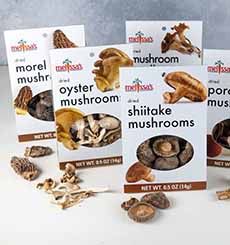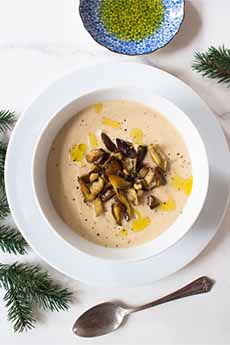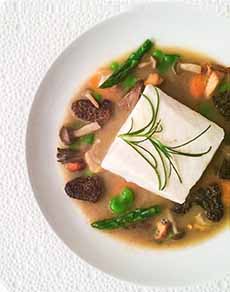GIFT: Gourmet Dried Mushroom Sampler & How To Use Dried Mushrooms
|
People who love to cook will appreciate this gourmet dried mushroom sampler from Melissa’s, an online purveyor of fine fruits and vegetables. Their Mushroom Medley Sampler contains individual packages of five gourmet mushrooms: See our favorite ways to use them, below. To reconstitute them, simply blanch them in boiling water for 2 to 5 minutes, or soak them for 30 minutes in lukewarm water. For even more flavor, soak the mushrooms in wine or consommé. The liquid, drained of the rehydrated mushrooms, is known as mushroom liquor. Reserve the liquor to add even more flavor to your dishes. Dehydrated mushrooms are not just for the pantry of a good cook. They’re a hit with: The flavor of dried mushrooms is slightly more concentrated than that of fresh mushrooms. As a result, they add more flavor than fresh mushrooms. Mycophagy, the act of consuming mushrooms†, dates back to ancient times. People foraged for them in fields and forests. Mushrooms Become Fashionable They were still gathered by country folk to supplement their diets, but mushrooms were not on the tables of the well-to-do. Until the middle of the seventeenth century. Then, a melon grower outside of Paris accidentally “discovered” the potential of growing and selling mushrooms. He (or his wife) poured out some water that had been used to wash wild mushrooms they had gathered. In a short while later, a crop of mushrooms sprouted in that spot of soil. It was the start of the era of the cultivated mushroom. The farmer evolved from melon grower to mushroom grower—a much more profitable undertaking since mushrooms became the hot new ingredient among the chefs of Paris. Other farmers joined the fold. The “champignon de Paris” became a must-have for cooks and their employers, and for home cooks. A couple of centuries later, Americans embraced the mushroom. One of the first English language mushroom cookbooks, published in 1899, is Kate Sargeant’s One Hundred Mushroom Receipts [source]. Mushrooms have remained an important part of Western cuisine. They have found their way into cuisines around the world. Today, more than 20 species are commercially cultivated, in at least 60 countries. The biggest producers are China, the U.S., Poland, The Netherlands, and India being were the top five producers in 2013 [source]. Today, the most commonly consumed variety of mushroom is the button mushroom, Agaricus bisporus. It comprises about 40% of the mushrooms grown around the world. It’s easy to grow‡. While it adds flavor to recipes and can be eaten raw in salads or on crudité plates, it is also the blandest mushroom. Mushrooms Are Not Vegetables! Some mushroom biology: Because they have no leaves, roots or seeds and don’t need light to grow, mushrooms are not a true vegetable. Botanists have given mushrooms their own kingdom in the taxonomy of organisms that is separate from plants and animals: Fungi. Vegetables, fruits and other plants are members of the Plantae kingdom. Here’s more about it. But you don’t have to remember the details: Just enjoy mushrooms often. A meaty portobello cap is a great substitute for meat. In fact, because of the way they are grown indoors, mushrooms are one of the most sustainable foods on the planet [source]. |
|
|
|
________________ *While dried mushrooms are typically re-hydrated, oyster mushrooms can be used in recipes without rehydration. †We’re not addressing medical, mind-altering or poisonous mushrooms here. ‡Some mushrooms are very difficult to cultivate, or totally resist cultivation and only are gathered wild. These include the chanterelle, hedgehog, lobster, morel and porcini mushrooms. Hen-of-the-woods and oyster mushrooms must be gathered wild.
|
||






